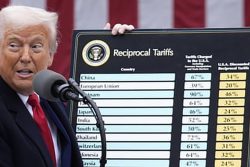 Being able to identify the policy changes that will transform the future is normally far from easy. Arguably, however, in the week past, the remarks of two world leaders make plain how the trajectory of global history is about to change.
Being able to identify the policy changes that will transform the future is normally far from easy. Arguably, however, in the week past, the remarks of two world leaders make plain how the trajectory of global history is about to change.
In a formal policy pronouncement on November 21, the US President-elect, Donald Trump, confirmed that on his first day in office he would sign a note of intent to leave the Trans Pacific Partnership, the Pacific Rim free trade agreement that does not involve China. Instead, he said, his administration would negotiate “fair bilateral trade deals that bring jobs and industry back on to American shores”.
His pre-recorded video coincided with a speech made one day earlier in Peru by China’s President, Xi Jinping. There China’s leader made clear that his country intends stepping into the trade policy vacuum the new US policy will leave. He did so by offering first the completion of the Regional Comprehensive Economic Partnership which brings together the nations of South East Asia and their main trading partners such as Australia and Japan, then joining this with several Latin nations in a Free Trade Area of the Asia-Pacific (FTAAP). While this will be no easy task, both groupings would then have China, the world’s second largest economy, at their core, exclude the US, and could ultimately account for 57% of global trade.
Mr Trump’s announcement was aimed at demonstrating to the US electorate that his priority will be to deliver his promised domestic agenda by protecting and isolating the US economy, through actions that he believes will create employment and strong growth. It is an approach that includes a focus on building domestic infrastructure, the negotiation of trade deals more favourable to the US, and much less certainly on finding ways to create low skilled jobs at a time when other nations are turning to automation, robotics, and an emphasis on education and human development.
In stark contrast, speaking on November 19 at the 24th Asia-Pacific Economic Cooperation forum (APEC), President Xi told business leaders from across the Asia-Pacific region and the Americas, “China will not shut the door to the outside world, we will open it even wider”. He also made clear a day later to participating political leaders, that China sees the Asia-Pacific region as an engine to push forward the development of the world economy.
He did not refer specifically to the US, but said instead that the world “cannot stop taking steps just because of temporary difficulties”. “History”, he said, “has shown us that there is no way out for protectionism”. He also made clear China’s interest in taking forward economic globalisation, and in a reflection of recent G20 thinking, called for closer international coordination on development practices, and the need to “pay attention to resolving the issues of fairness and equity”.
While there remain reservations, most notably in Japan, about what is being proposed by China, at the APEC meeting the Australian and New Zealand Prime Ministers made clear to the media their view that China would now fill the void of US leadership and that global trade dynamics would change.
Latin participants and media commentators at the event observed that there was a real sense that global leadership was passing to China, in a forum that had previously always been dominated by an exhibition of the US government’s global will.
Accounts also suggest that President Obama, who was present at the meeting, was left trying to reassure allies that the US was not withdrawing from the Latin America or the Pacific region.
Strikingly, however, at a collateral event, he told students and young leaders from Latin America that Mr Trump would almost certainly re-examine US trade deals in Latin America, and noted that tensions may arise around trade more than anything else. He did not, however, expect significant political change in hemispheric relations as US security depended on stability in Latin America and the absence of mass migration.
There are powerful and multiple messages in this for the Caribbean and Central America. The first is that if the US is to renegotiate its key trade relationships on a bilateral basis and, as is widely assumed, abandons the Transatlantic Trade and Investment Partnership (TTIP) with Europe, China is set to become the new global champion of freer trade. This will drag Europe, a detached UK, and eventually India and Japan, to say nothing of Canada or Mexico into new configurations that respond to China’s apparent willingness to open its growing market by gradually reducing its tariffs and restrictions on goods and services.
The second is that if China is to deliver greater equity through economic globalisation, the Caribbean will need to develop a calibrated dialogue with Beijing that goes far beyond investment and development financing. It will need to find ways in which the region might have improved market access and support for its exports of goods and services.
The third is to accept that the world is being reshaped. Despite the Caribbean’s geographic proximity to the US, its historic ties to Europe and its shared values and close economic and political relationship with both, there is a need to recognise that China’s rise is of profound significance, is more than just an economic phenomenon, and that the world’s centres of gravity are relocating.
And the fourth is the need to develop policies that respond to the emergence of others vying for global influence in alternative ways. Already, Angela Merkel, Germany’s Chancellor, has made clear that she believes that Europe is now the repository of liberal social values and must do more to defend them globally; there are early indications that Canada may be moving to increase its profile in the Latin America and the Caribbean; and perhaps more darkly, Russia has begun to demonstrate its wish for military and geo-strategic equity with the US and wants to restore the idea of spheres of influence.
Despite the smallness of the region, these tectonic shifts in international relations should oblige every Caribbean and Central American leader to observe them closely and to begin to formulate new national and regional perspectives.
Previous columns can be found at www.caribbean-council.org









